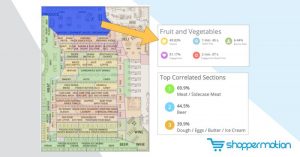Understanding changing consumer behavior is essential for retailers looking to stay competitive in today’s marketplace. By tracking and analyzing consumer behavior, retailers can make informed decisions about their products, services, and marketing strategies.
In-store analytics is a powerful tool for gathering data on consumer behavior. It allows retailers to get a deeper understanding of how customers interact with their products in a physical retail setting.
This article aims to provide a comprehensive overview of how retailers can use in-store analytics to understand changing consumer behavior. It will explore the types of data and the tools available for gathering and analyzing this data. Ultimately, will explore the key metrics that retailers should consider when tracking consumer behavior.
Finally, it will explore the importance of ongoing analysis and the role of technology in understanding changing consumer behavior.
Gathering data on consumer behavior
There are several types of data to gain insights into consumer behavior in a physical retail setting. This can include data on foot traffic, sales data, customer demographics, and customer interactions with products and staff.
Foot traffic data for understanding changing consumer behavior
With in-store technology installed throughout the store, retailers can collect foot traffic data. By tracking the movement of customers within the store, retailers can get insights into which areas of the store are most popular. Also, which are the products that are drawing the most attention.
Sales Data for understanding changing consumer behavior
Using point-of-sale systems to collect Sales Data. POS systems can track information about each purchase made in the store. Amongst others, including data about the items purchased, the total amount spent, and the payment method used.

Customer Demographics
Using customer surveys and focus groups to gather Customer demographics. This allows retailers to collect more qualitative data on their customers’ preferences. Additionally, consumer behaviors, and motivations.

Customer interactions for understanding changing consumer behavior
Finally, retailers can track customer interactions with products through customer feedback and reviews. Also, by observations made by the store’s staff. Regarding reviews, some studies show that reviews impact 80% of purchases, hence consumers see them as relevant when looking to purchase a product.
In summary, tools for collecting in-store data can include all kinds of in-store tracking technology to obtain:
-
- Foot traffic and customer movements
-
- Point-of-sale systems to track sales data
-
- Customer surveys and focus groups to gather more qualitative data.
Overall, it’s important to choose the right tools and methods for collecting data that align with the specific goals and needs of the business.
Understanding changing consumer behavior data
It’s important to analyze data in order to gain insights into consumer behavior. There are several key metrics to consider when analyzing consumer behavior data, including conversion rate, average order value, and customer lifetime value.
- Firstly, the conversion rate is a measure of how many customers make a purchase after visiting the store. A high conversion rate indicates that the store is effectively converting visitors into customers, while a low conversion rate may suggest that there are areas for improvement in the store’s layout, product selection, or customer service.
- Secondly, the Average Order value. This is a measure of the average amount spent per purchase. A higher average order value may suggest that customers are purchasing more expensive items or are adding additional items to their cart.
- Lastly, the Customer lifetime value is a measure of the total value that a customer is expected to bring to a business over the course of their relationship with the company. By understanding the lifetime value of their customers, businesses can make informed decisions about how to best invest in customer acquisition and retention.
Best practices for data analysis include setting clear goals and objectives, creating a plan for data collection and analysis, and regularly reviewing and updating the analysis process. It’s also important to consider the context in which retailers collect data, as it can impact the results and conclusions that are drawn.
Using consumer behavior insights to drive business decisions
Insights gained from analyzing consumer behavior data help inform a wide variety of business decisions. For example, product development, pricing strategy, and marketing efforts. If data shows that a particular product is popular among a certain demographic, a retailer may decide to focus marketing efforts on targeting that demographic.
It’s important to regularly review and update consumer behavior insights, as consumer preferences and behaviors can change over time. By continuously tracking and analyzing consumer behavior data, retailers can stay ahead of trends and make informed decisions that drive growth and success.
One way to stay on top of changing consumer behavior is to regularly conduct market research. This can include surveys and focus groups with customers, as well as competitive analysis to see what other businesses in the industry are doing. By staying up-to-date on market trends and consumer preferences, retailers can adapt and pivot their strategies as needed.
Another key factor to consider when analyzing consumer behavior is the impact of technology. With the proliferation of online shopping and mobile devices, consumer behavior is constantly evolving.

Retailers need to be aware of how these technological changes are impacting consumer behavior. Be prepared to adapt their strategies accordingly.
Understanding changing consumer behavior with in-store analytics
In-store analytics can be an invaluable tool for understanding changing consumer behavior. By collecting data on customer interactions with products, foot traffic patterns, and sales data, retailers get a comprehensive view of how consumers are interacting with their products in a physical retail setting.
Shoppermotion has developed innovative technology for collecting in-store data. Shoppermotion is able to track shoppers’ paths throughout the store. Provides insights into which products/areas of the store are most popular. With this information, retailers can optimize the store layout. Additionally, improve their product placement and marketing efforts to meet the needs and preferences of customers.
In addition to tracking foot traffic patterns, Shoppermotion’s technology can gather data on customer interactions with products. This includes information on:
-
- How long customers are spending in front of certain products
-
- Which products are being picked up and examined
- Which products are being left on the shelves
This data can provide valuable insights into consumer preferences and behaviors. Shoppermotion helps retailers to make informed decisions about their products and marketing strategies.
Overall, in-store analytics is a powerful tool for understanding changing consumer behavior. Ultimately, adapting to the needs and preferences of customers. By leveraging the latest technology and data analysis techniques, retailers can get insights into consumer behavior. Moreover, make informed decisions that drive growth and success.
Conclusion
In conclusion, understanding consumer behavior is crucial for retailers looking to stay competitive in today’s marketplace. In-store analytics is a powerful tool for gathering data on consumer behavior. It allows retailers to make informed decisions about their products, services, and marketing strategies. By regularly reviewing and updating consumer behavior insights, businesses can stay ahead of trends and ultimately drive growth and success.
It’s important for Retail Media Networks to stay up-to-date on market trends and consumer preferences. Also, being aware of the impact of technology on consumer behavior to effectively track and analyze consumer behavior over time.






